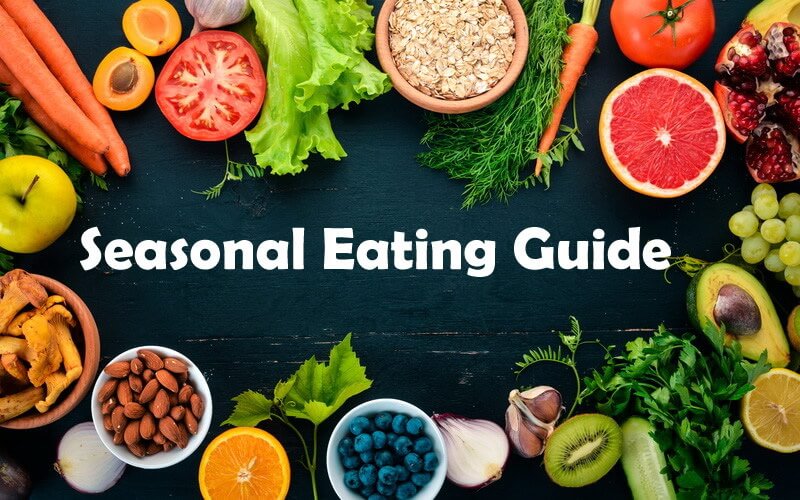Seasonal Eating Guide
Seasonal eating refers to the practice of consuming foods that are naturally in season during a specific time of the year. This approach to eating is based on the idea that foods are at their best in terms of flavor, nutrition, and affordability when they are harvested or grown during their natural season.

Why Eating in Season Remains Important
Seasonal eating is a dietary approach that involves consuming foods that are in season during a particular time of the year. This practice has several benefits, including:
1. Freshness
Seasonal foods are typically harvested at their peak ripeness, so they are often fresher and more flavorful. This can make your meals more enjoyable.
Foods planted and harvested in season tend to thrive in ways that out-of-season foods do not. Vegetables and fruits need enough time to develop during the growing season in order to fully mature. In addition, they need the right conditions to flower and produce fruit. Unless timed properly, the result can be insufficient texture, flavor, or nutrient content in comparison to the expectations that we would normally have for any particular vegetable or fruit. One great way to summarize these circumstances is with the word "freshness"! Freshness means thriving, freshly harvested, in-season foods!
2. Nutrient Density
Seasonal produce often contains higher levels of essential nutrients because it is allowed to fully mature before harvesting. This means you get more vitamins and minerals in your diet.
In one study, researchers found the flavonoid amounts in broccoli to vary fourfold depending on the season in which it was grown. three-fold differences in the vitamin C content of spinach harvested in summer versus winter. In another study, the anthocyanin content of pomegranate was determined to vary twofold in relation to season. Vegetables and fruits grown in season are not guaranteed to have the most nutrients since there are many different factors at work here (for example, soil quality, water availability, geography, and landscape). But you can increase your chances of higher nutrient quality by selecting vegetables and fruits grown in season.
3. Cost-Effective
Seasonal foods are usually more abundant and, therefore, less expensive. When you buy in-season, you may save money on your grocery bills.
The fact that vegetables and fruits tend to thrive when they are in season can also help make them less expensive. Sometimes you can get fantastic deals on vegetables and fruits when they are at their seasonal peak! One of the reasons that you can end up with these cost savings involves the balance between supply and demand. When plants thrive, there can be an overabundance at the time of harvest, and lower prices can help clear the shelves of this overabundance.
4. Variety
Seasonal eating encourages a varied diet, as different foods come into season at different times. This can help you explore new recipes and flavors.
Guides for Eating Seasonally
To enjoy the full nourishment of food, you must make your menu a seasonal one. In different parts of the world and even in different regions of one country, seasonal menus can vary. But here are some overriding principles you can follow to ensure optimal nourishment in every season:
- In spring, focus on tender, leafy vegetables that represent the fresh new growth of this season. Greens like Swiss chard, spinach, Romaine lettuce, fresh parsley, and basil should be on your plate to represent the greening that takes place in spring.
- In summer, stick with light, cooling foods in the tradition of traditional Chinese medicine. These foods include fruits like strawberries, apples, pears, and plums; vegetables like summer squash, broccoli, cauliflower, and corn; and spices and seasonings like peppermint and cilantro.
- In the fall, turn toward the more warming autumn harvest foods, including carrots, sweet potatoes, onions, and garlic. Also emphasize the more warming spices and seasonings, including ginger, peppercorns, and mustard seeds.
- In winter, turn even more exclusively toward warming foods. Remember the principle that foods that take longer to grow are generally more warming than foods that grow quickly? All of the animal foods fall into the warming category, including fish, chicken, beef, lamb, and venison. So do most of the root vegetables, including carrots, potatoes, onions, and garlic. Eggs also fit in here, as do corn and nuts.
Priorities for Eating in the Season
When possible, choose high-quality, freshly harvested, locally grown vegetables and fruits. These vegetables and fruits are not only guaranteed to be in season but to have been spared long-distance transport and prolonged storage.
High-quality, recently harvested, regionally grown vegetables and fruits are the next best option. While these foods are not grown in your immediate community, they are still in-season in your region of the country and are likely to have undergone less transport and storage than foods grown at a much greater distance from your community.
High-quality vegetables and fruits grown a great distance away from your community might still have been grown and harvested in season in their region or country of origin. These foods can still be good choices. However, they are likely to have been subjected to greater storage and transport and to have arrived at your local grocery store much longer post-harvest.
Keep in mind that the specific foods in season can vary depending on your location and climate. It's a good idea to check with local farmers' markets or seasonal food guides to find out what's currently in season in your area. By embracing seasonal eating, you can enjoy the benefits of fresh, nutritious, and locally sourced foods while also supporting the sustainability of your community's food system.